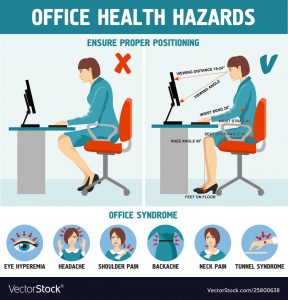As most of us begin to work from home, we’ll have to start getting used to our new routine and that means, paying more attention to proper ergonomics and how we interact with our home workspace. As home is a place of flexibility and comfort, you might become acclimatised to your home environment and notice yourself rolling out of bed and making your daily commute to your couch as you start the day, hunched over a coffee table and slipping into a bad working routine.
If you’ve noticed a strain in your back, a knot in your neck or a pain running through your shoulders as you type, these could be signs of improper ergonomics and body fatigue as your new environment could be impacting the way you work.
Even when working from your kitchen table, it’s important to maintain proper ergonomics, which you can continue to do when you return to the office.
Here’s a few tips and tricks on proper ergonomics when working from home we’ve curated for you, to help you maximise your home working environment as much as possible:
1. Monitor / Laptop Placement
Notice where your computer screen is placed and make sure it’s directly in front of you at about an arm’s length away. As we only read from the top third of a computer screen, it’s important that the top border of the computer screen sits at eyebrow height. If you wear bifocals, lower the monitor an additional 2.5-5cm for a more comfortable viewing.
2. Chair and Elbows at Desk Height
It’s important to choose a chair that supports your back posture. Choose a chair which has a hard and stable back piece and if you can, adjust the height of your chair so that your feet rest flat on the floor or on a footrest. Dangling feet and crossed legged can cause lower back pain, which is why if you don’t have an adjustable chair, find a chair that allows your feet to touch the floor. Your thighs should also be parallel to the floor.
3. Keyboard and Mouse
If you’re working with a laptop keyboard, your shoulder can roll in and cause a strain in your arms, shoulders and back. This is why you should find a standard keyboard to work on.
Make sure to place your mouse within easy reach and while typing or using your mouse, keep your wrists straight, your upper arms close to your body and your hands at or slightly below the level of the elbows.
Your elbow should remain at desk height and your forearm should be resting on the desk with a 90-degree angle running for your shoulder to your hands, bending at the elbow. If possible, adjust the sensitivity of the mouse so you can use a light touch to control it. Try and also alternate the hand you use on your mouse or trackpad.
4. Take Regular Breaks
It’s important to take regular breaks when you’re working behind a desk to avoid spending too much time sitting down in front of a screen. This can impact your posture and cause further strain on your neck, shoulders and back. Aim to work for periods of 3-40 minutes and then do a 1-2minute neck stretch and/or get up from your seat for a quick stretch and walk around, before resuming.
We hope these tips and tricks help makes working at home easier for you, helps reduce sedentary feelings and keep you feeling energised.
If you have any further questions on proper ergonomics or would like our advice on your work station set up, please don’t hesitate to give us a call on (02) 9588 7000 or send us a photo of your home office to [email protected], and we can have a practitioner assess your set up for you.
We are also still open if you’d like to see one of our chiropractors for an adjustment. You can book online here.






